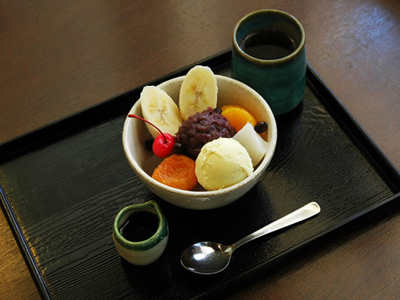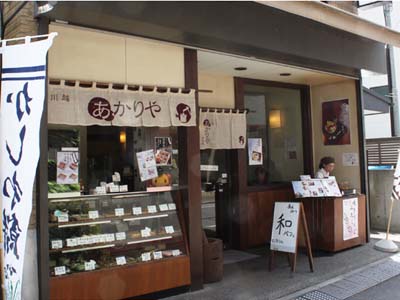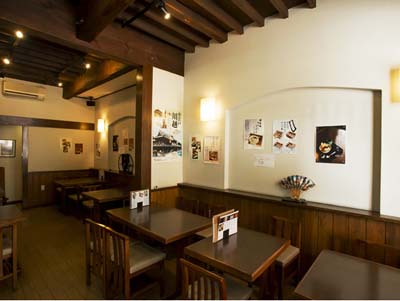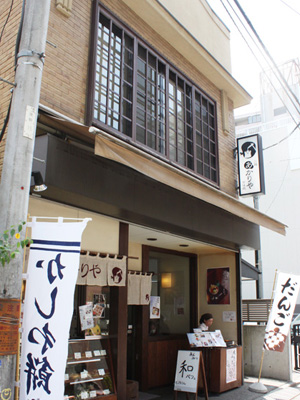Kanmidokoro Kawagoe Akariya
Kawagoe is a city that has been receiving attention as a tourist attraction close to Tokyo. As you walk through the main street that stretches right from the station, you will see a sweets shop there. It is the Kanmidokoro (confection shop) Kawagoe Akariya. Due to its location, it has become a place to ask for directions; almost like a checkpoint for the famous area with warehouses constructed in a traditional style called kurazukuri from the Edo period.
Since when have you been in business?
Since 2001, so is has only been about 12 years.
I'm surprised because the exterior of the building looks aged. Is the establishment new as well?
My family originally ran a different business here until I took over and began this sweets shop. I used to be a salary man, but I quit because I wanted to run my own business. I achieved my sweets-making skills at a relative's Japanese-style confection shop. That was around the time when more tourists began visiting Kawagoe, so I thought that a confection store might do well.
I visited your website. It seems that you are very selective about the ingredients. What drives you to put so much time and work into making anmitsu (a traditional Japanese dessert)?

Nowadays, anmitsu is sold in many places from supermarkets to restaurants and caf├®s, and most of them are made from mass produced ingredients. But since we make all of our products right here, we can make everything from scratch. That naturally requires me to put a lot of work into it.
Where did you come up with the idea of starting a delivery service for your anmitsu?
Selling only at the store shrinks the market. If I limited my business to just this store, someone in Kansai would not be able to come even if that person wanted to. To put it to an extreme, only those living within a kilometer radius would be able to come. If delivered, many more people would be able to enjoy it.
Do you actually get orders from distant locations?
Yes; I get orders from all over Japan, from Hokkaido to Okinawa. However, because the anmitsu expires quite quickly, I have to ask my customers in Okinawa to consume them on the day of delivery which is two days after the order is placed. On the contrary, some of them like that because it gives it this sense of it being something special unlike some products in vacuum packages. It seems like it feels new to them to be told that something won't last long rather than being told that it is good for another month or two.
If you have an episode with a customer that you would like to share, I would like to hear.

In Akariya's website, there is a page called "Let's go explore Kawagoe." I am very happy that someone came to me and said, "I decided to come here after seeing your web site." I feel thankful and pleased that almost everyday, I have customers who come with the map printed out. If the website is attracting tourists, that is a wonderful thing, even if they don't come to buy at my shop.
I saw that page as well. What was your reason for making the page?
Running a business here, I get asked for directions almost every day like, "Where am I right now?" or "How do I get to the area where there are the kurazukuri warehouses?" That made me realize again that running a business in Kawagoe means to be close to those who come to visit. So I thought that if I were to make a website, I would have to make it into something that the tourists would want to look at.
Kawagoe is a castle town. If you take a look at the map, you will immediately notice that the streets are intertwined. There are many dead ends around the castle. It was purposely designed that way so that when under attack, the enemies would not be able to invade so easily. Today, that makes the map look like a maze and gets many people confused.
With the online shop and all, it seem to me business is going well each day. Do you have any future visions?
I had originally been aiming for a shop that would attract anyone, so I am truly grateful that customers of all age groups come in everyday. I would like to continue providing service that can please everyone from the locals to the tourists. I want to contribute to the development of Kawagoe, and I will maintain that attitude towards my business.
Do you have customers that come from overseas?

Yes I do. When they order a udon and anmitsu set, I explain to them using gestures that the syrup is for the anmitsu, and not for the udon noodles. As long as I put my feelings into it, they will understand everything. They told me it was delicious. Since we are Japanese-styled, among the many customers from abroad, some of them come with their host family. They probably come for the full Japanese experience; they leave here looking satisfied.
The tie between Kawagoe and your shop is very close. You must have strong feelings towards Kawagoe as well.
To me, Kawagoe is where I was born and grew up. I have a sense of attachment towards many of the things here, but Kawagoe now ranks first place as Saitama's most want-to-live-in city. Not only is it a comfortable place to live, it also has the touristic areas where you can enjoy historical sites. I guess this two in one characteristic makes it seem like an ideal place to live. Kawagoe has become what it is today because of the events like the Spring Festival and the Summer Festival which involves the community which is another charm of this city. In that sense, I want to participate in developing this city through my shop.
Is there something you would like for people abroad to know about Japan?
I think one of the best things about Kawagoe is its accessibility. Tourists can come to Kawagoe in a single train ride as an extension to their Tokyo tour. People can enjoy traditional and historical Japanese architecture, food, and such without having to go all the way to Kyoto or Nara. Tourists can fully enjoy the city in about half a day, so the convenience is definitely one of its appealing points that should be emphasized.
As we've discussed a little bit about it before, Akariya also has an exterior that reveals its long history. It seems that it is a kanban architecture.

Yes it is. It was built in 1993. Basically, kanban architecture is a household with a store. This is a kanban architecture because I live here. It is built in a way that it is appealing as a business facility. This shop is a bit Western, but because the exterior is designed as a business sign and a house, its considered as one of them.
Lastly, tell us about your views towards Kawagoe as well as Akariya as "cool Japan".
When I thought about what "cool" really is, I came up with the idea of something being "independent." I think that being independent is not being influenced by the society's trends and tendencies. Japanese culture has heavily been influenced by foreign cultures, but even so, it has transformed them to make it adapt to itself.
My wish is for Kawagoe to be that kind of cool Japan.
I do too, and I think it has. When I was a child, Kurazukuri had a negative image like old and dull. But as people began to rethink of it as a resource of tourism, more and more people began to visit.
Being a little separated from the kurazukuri, Akariya seems independent to me. How do you feel about that?
It is something that I have been feeling about Akariya as well. It may at first seem like the center of the city, but still distant from the main attractions. Yet, people have to pass by here to get there. In starting a business here, I have been aware that it is located in a tourist area, and that they would come as customers. It is actually has become so. People both young and old come to my shop. Usually, the locals come during the weekdays, and the visitors on the weekends.
